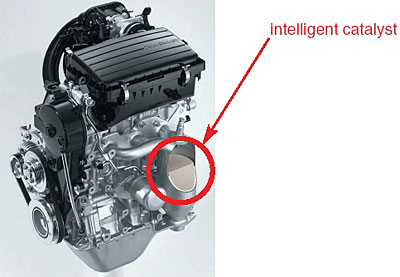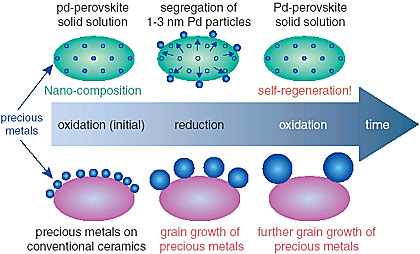This is the first time that an intelligent catalyst, whose precious metals are regenerated automatically, has been developed to reduce harmful emissions from gasoline engines. As a joint research effort between JAERI and the Daihatsu Motor Co. Ltd., we have discovered the mechanism of the regeneration phenomenon by means of synchrotron radiation X-rays at SPring-8. It is now possible to save enormous quantities of precious metals that would otherwise be consumed in the production of automotive catalytic converters.
Gasoline engines exhaust NOx, unburned hydrocarbons (HC), and CO as pollutants. Automotive catalysts usually convert these pollutant emissions into innocuous materials, such as CO2, H2O, and N2. Conventional catalytic systems employ a considerable excess of precious metals, such as Pt, Rh, and Pd, to accomplish this.
Regulations to reduce automotive emissions are now being strengthened. To ensure immediate activation of the catalyst on engine start-up, the catalyst has recently been installed at the hottest part of the engine (Fig. 5-10), which demands heat resistance of the catalyst.
The catalyst is exposed to the hot exhaust gas during vehicle use. The catalytic activity usually deteriorates because the agglomeration and growth of the precious metals reduces their overall surface area, which is necessary for the catalytic reaction. A Pd-containing perovskite oxide was synthesized. This new catalyst structurally responds to the inherent redox fluctuations in exhaust gas composition, which happens, for example, during acceleration and deceleration of the automobile. Pd reversibly moves between the inside and outside the perovskite lattice to maintain its catalytic action.
Therefore, the agglomeration and growth of the metal particles are suppressed, and the particles maintain their activity. The Pd-perovskite catalysts can refresh themselves while the vehicle is being driven (Fig. 5-11).
The intelligent catalyst can reduce by 70-90% the amount of precious metals used to control pollutants and still meet the new ultra-low emission standards for vehicles.
|

